A bit of history
Cupronickel as such does not exist in nature: in fact, it is a group of copper compositions with the addition of nickel, iron, zinc, manganese and some other metals. Most often it is an alloy of copper and nickel, which has its own specific features and properties. According to historical sources, it was invented in China in the 8th century BC and given the sonorous name "pakfong". All attempts to unravel the composition of "Chinese silver" by European alchemists were unsuccessful: only by the beginning of the 19th century did mass production of cupronickel begin in Germany. At first, the European nobility considered such dishes "the dishes of the poor", and therefore still preferred dishes made of other metals - gold and silver. Only by the 20th century, production increased momentum everywhere. The attractive appearance of cupronickel served for the manufacture of cutlery, candlesticks, jewelry and other decorative elements. Wear-resistant, easy to maintain and not too expensive, the alloy is appreciated and actively used in households.
Interestingly, psychologists consider cupronickel dishes useful for the psyche. Unobtrusive, calm, noble brilliance of the alloy calms the nervous system, relieves tension and tunes in to a calm rhythm.
What is cupronickel: pros and cons
The metal is similar to silver. The material has been invented twice. The first time this happened in China almost 3 thousand years ago. From cupronickel minted coins, made jewelry.
When nickel silver came to Europe in the Middle Ages, they were valued higher than silver ones. The best alchemists tried to unravel the composition, but in vain.
The secret was revealed only at the end of the 18th century by the French scientists Mayo and Chorier. The alloy was called myshor, as a derivative of their surnames. Then in German the word was distorted to Melchior.
Today, the following types of cupronickel products are produced:
- dishes (trays, coffee pots, wine and coffee sets, vases, Turks, glass holders);
- cutlery (forks, knives, pastry spatulas);
- Jewelry;
- commemorative coins;
- candlesticks;
- souvenirs.
The alloy is used in electrical engineering. It serves as a raw material for the manufacture of medical instruments.
Cupronickel products look beautiful. They are almost not amenable to mechanical damage and have the following advantages:
- durability (cupronickel cutlery lasts for several generations),
- corrosion resistance,
- hygiene,
- strength,
- environmental friendliness,
- poor thermal conductivity
- deformation resistance.
Cupronickel knives and forks heat up slowly, so they are a pleasure to use. But they have two big drawbacks. They quickly lose their luster and require careful care. And they are often covered with a black coating, so they need to be cleaned regularly.
Melchior features
Due to the peculiarities of its composition cupronickel is often subjected to darkening. This alloy is sensitive to high humidity.Its blackening can cause improper storage and non-compliance with basic recommendations for the care of such devices. If you do not clean the products from dirt and dark areas in time, the situation will only worsen.
In addition to plaque, green stains will begin to appear. The devices will not look quite aesthetically pleasing, and using them is even dangerous to health. At the same time, cupronickel products can “boast” of the following advantages:
- they are of low cost;
- have a presentable appearance;
- their service life is quite long;
- they are durable and resistant to rust.
Useful and harmful properties
Cupronickel is an alloy whose main component is copper. There is a misconception that the use of such utensils can be harmful to health. When used correctly, cupronickel kitchen utensils are completely safe.
Melchior benefits include:
- The durability and strength of cupronickel cutlery - the low cost of the material allows you to produce products more massive, which ensures their strength. Also cupronickel, due to its chemical composition, is almost not susceptible to mechanical damage, unlike silver.
- Cupronickel dishes look aesthetically pleasing - when serving, the cutlery looks expensive, the silver-plated coating makes them almost indistinguishable from silver ones.
- Cupronickel products are not susceptible to corrosion, with proper care they can last for several generations.
- The low thermal conductivity of the alloy makes it comfortable to use. Unlike silver, cupronickel heats up very slowly.
Cupronickel cutlery has some disadvantages:
- With improper care, the products may darken. You can avoid this by protecting the dishes from moisture. It is not recommended to use products with abrasives for washing products. If the appliances are still dark, it will be easy to lighten them with home cleaning.
- Uncoated cupronickel can give food a slight metallic taste. It is insignificant and will not be noticeable to everyone. To avoid this, a layer of tin can be applied to the product. Only after that it is covered with a silver or gold coating.
- It is believed that cupronickel is harmful to health, since when heated, and also as a result of contact with certain products, copper oxidizes and releases toxic substances. To prevent this from happening, cupronickel dishes are not recommended for cooking on the stove or in the oven.
Cupronickel cookware is more demanding to maintain than stainless steel and other materials.But it emphasizes the sophistication of the festive table setting in the most profitable way.
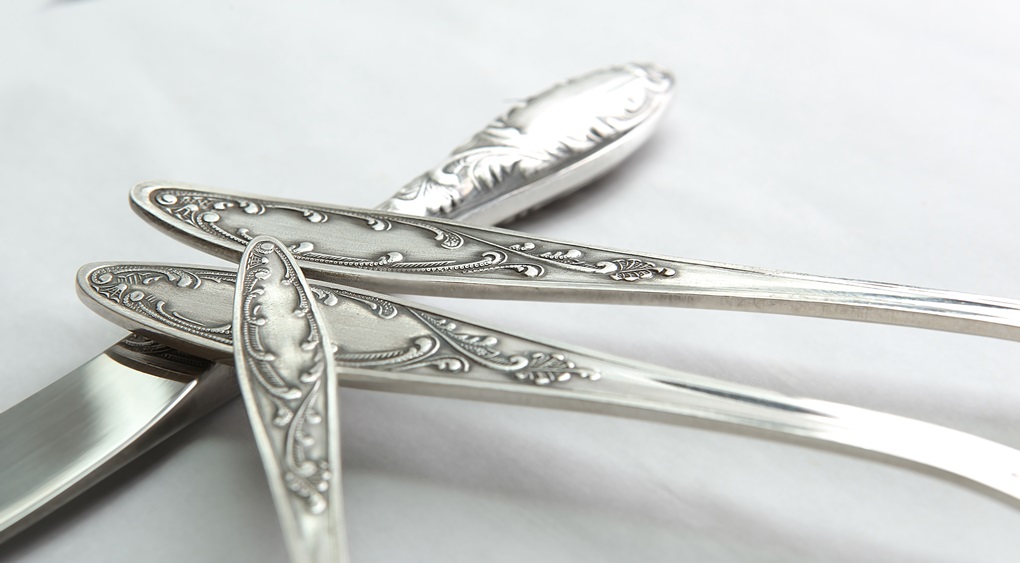
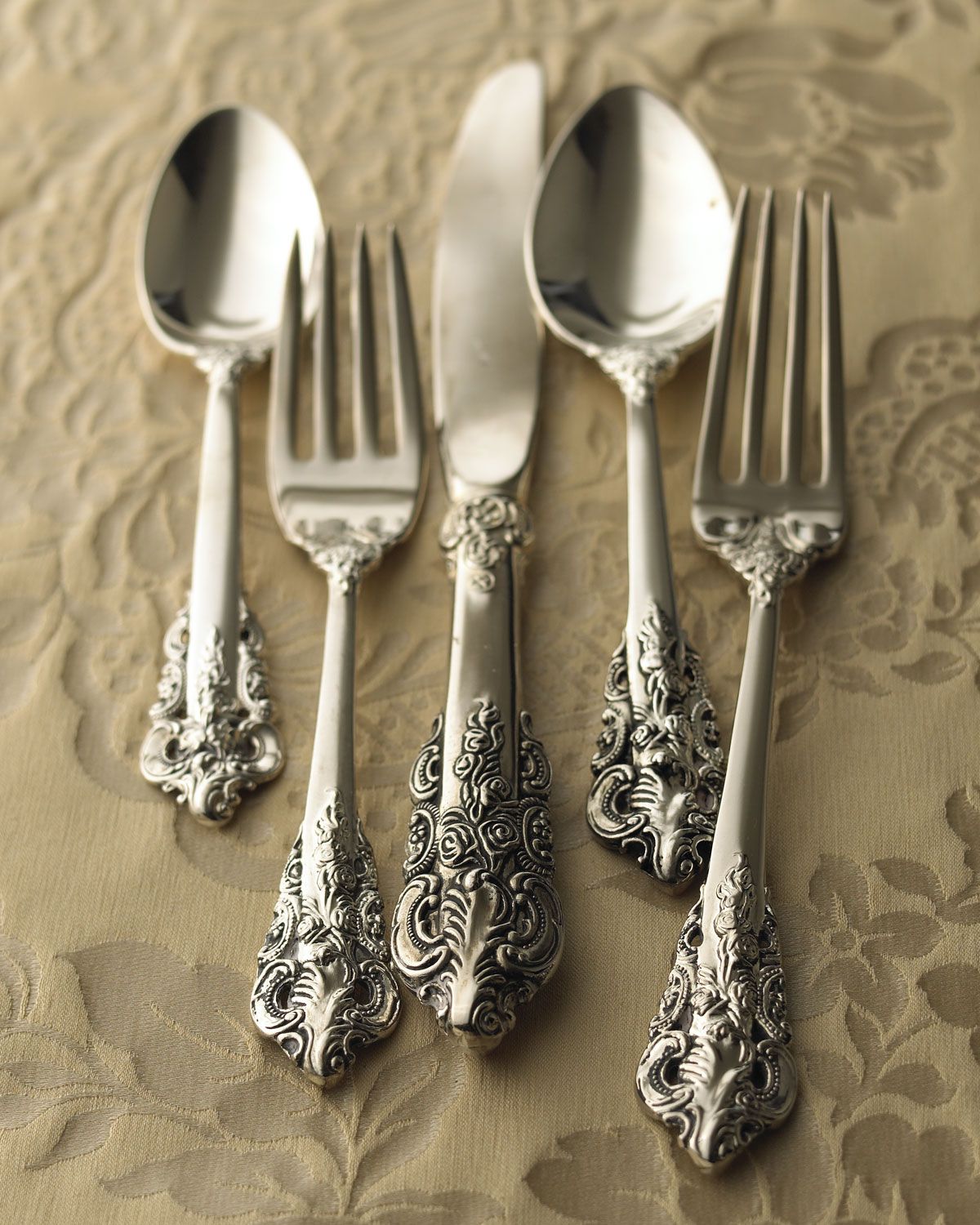
Varieties of dishes
Not all types of kitchen utensils can be made from nickel silver, since it is undesirable to expose it to high temperatures. Cupronickel crockery is mainly used as cutlery or as a design element.
Cupronickel products are very diverse:
- Cutlery - knives, forks, tableware, dessert, teaspoons. Most often, the kit is produced in the same style, which gives the device a special harmony.
- Cup holders - the strength and low thermal conductivity of cupronickel ensures safety and comfort when using.
- Samovars, Turks - have a tin coating inside, which makes cupronickel safe for use at high temperatures.A cupronickel samovar will be a great gift for lovers of antiques. In a copper coffee pot, coffee will be prepared correctly due to the desired temperature regime.
- Vases, dishes, trays - thanks to their stylish design, they will become an excellent decor element for a festive table or interior.
- Tea and coffee sets have a variety of packaging and design. The sets include teapots for brewing or coffee pots, a set of cups or coasters for any number of people, as well as trays, candy bowls, sugar bowls, and other attributes for serving tea.
- Wine sets - most often consist of a tray, a jug for wine, a set of saucers, goblets or stacks for drinks.
The appearance of cupronickel cutlery can be very diverse. Now the main trend is a minimalist style, strict lines and a complete lack of decor. Such devices are convenient to use in everyday life. But for special occasions, you can purchase sets decorated with chased patterns or engraving. Items inlaid with ceramics and enamel look no less chic. A special category includes festive cutlery with a gilded or silver plated finish, which has a higher cost.
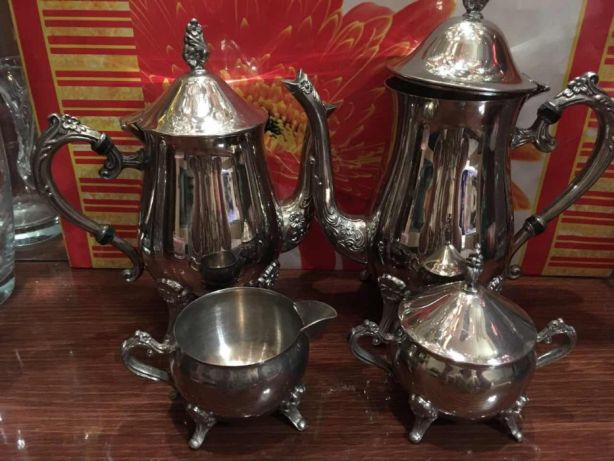 A tea set
A tea set
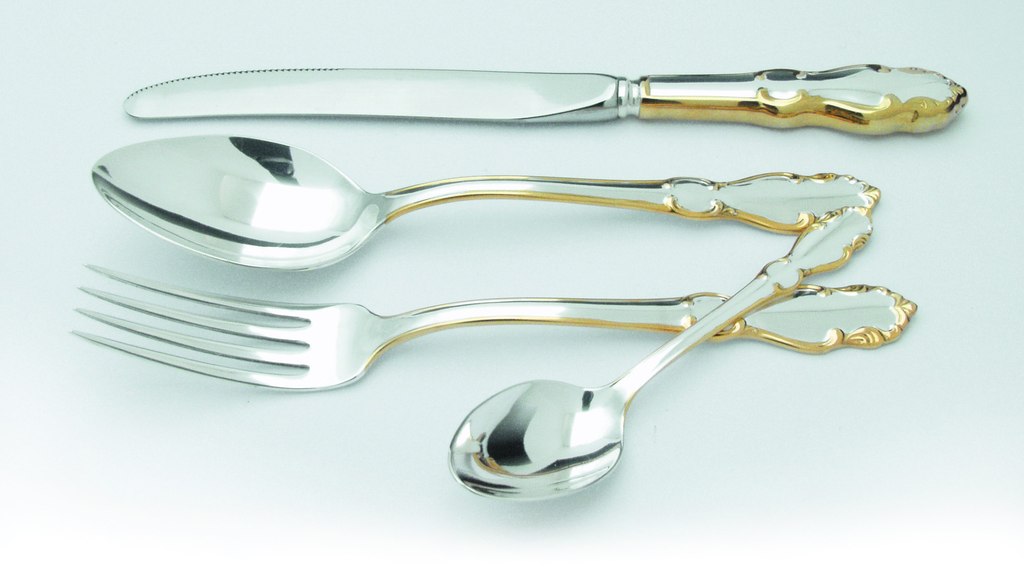 Forks, spoons, knives
Forks, spoons, knives
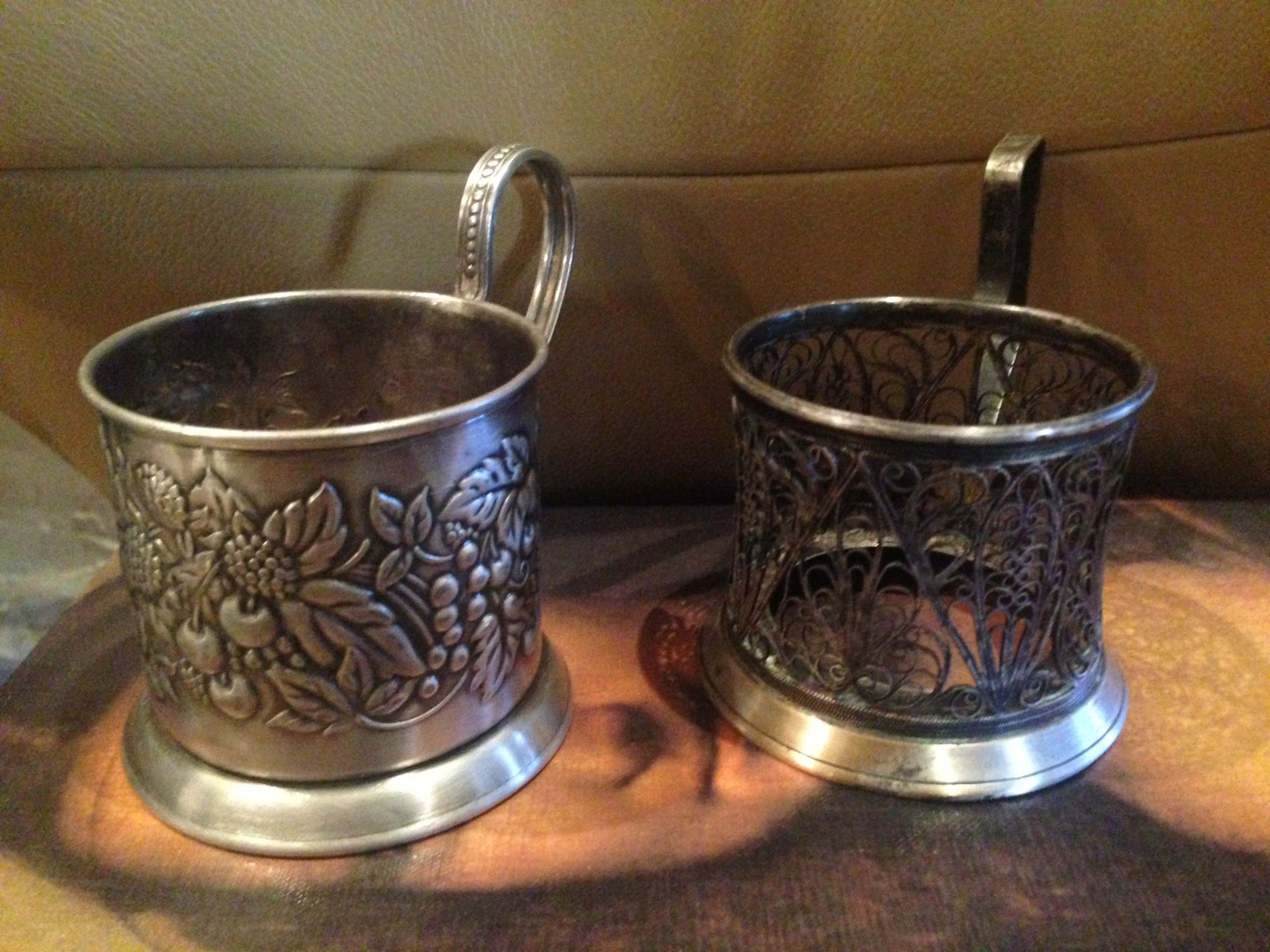 coasters
coasters
 wine set
wine set
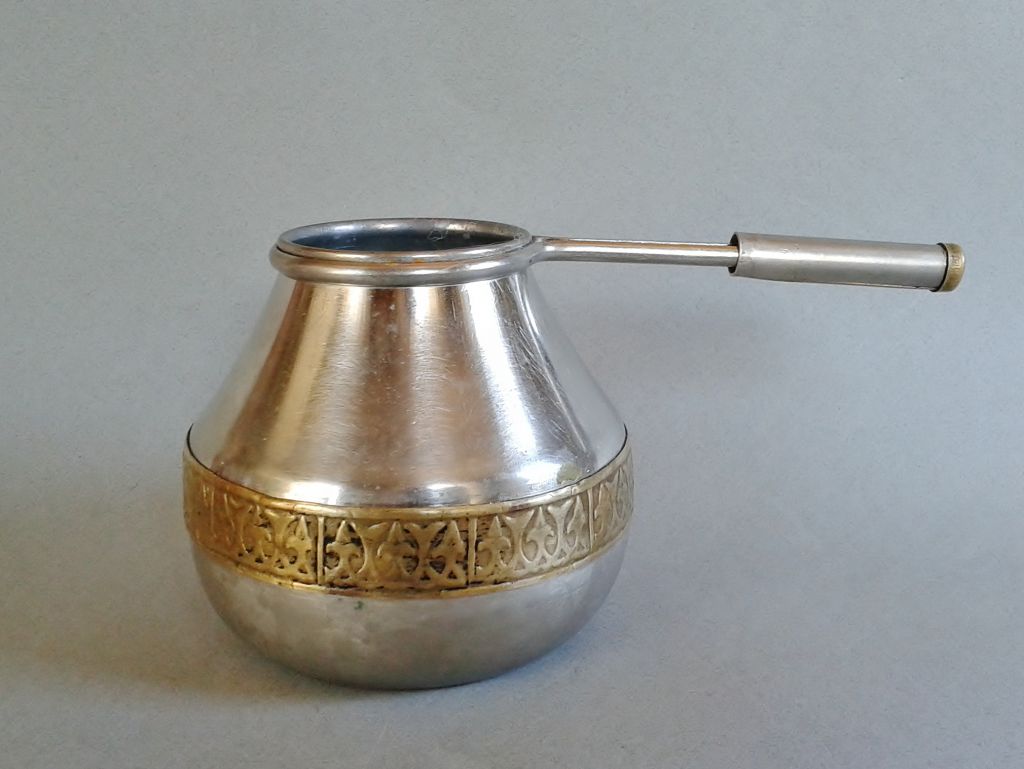 Turk
Turk
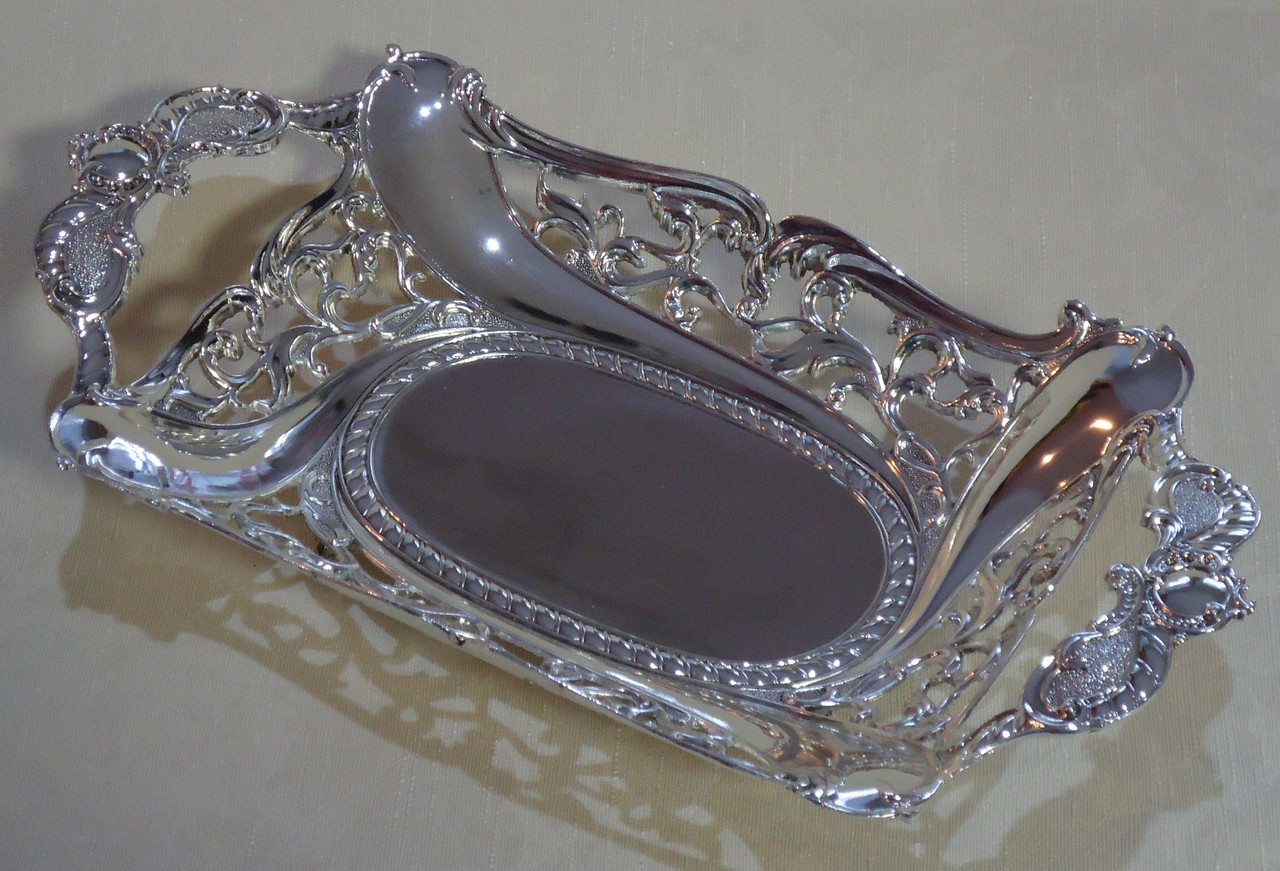 Tray
Tray
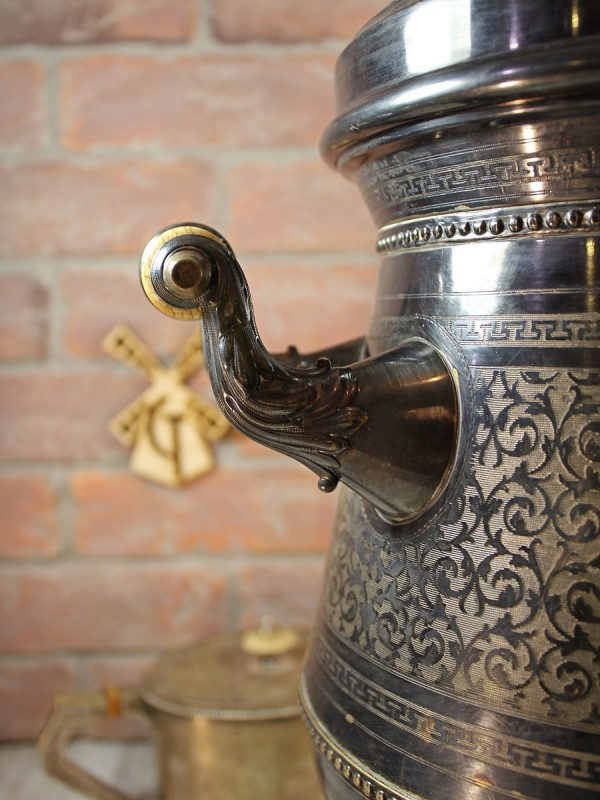 Samovar
Samovar
How to distinguish cupronickel from silver
Due to the similarity of cupronickel products with silver ones, it is not always possible to distinguish them without knowing some subtleties:
- The presence of a sample - on a product consisting entirely of silver, there will be a factory sample - 925 or 875. On a cupronickel product from an honest manufacturer, MN or MNTs is marked (from the composition of the alloy - copper, nickel, sometimes zinc).
- Smell - with a good sense of smell, you can conduct such a test. Silver has no odor at all, but on a cupronickel product, you can catch a barely noticeable sour smell of copper. This test is relevant only for products made of pure cupronickel without any coating.
- Ringing - when tapping on a silver product, a characteristic thin, gentle ringing is heard, while cupronickel products will respond with a dull sound.
- Iodine test - when it hits a silver product, iodine will leave a dark spot, which will then be very difficult to remove, but iodine will not react with cupronickel. It is recommended to use this method in extreme cases. If the item turns out to be silver, this test can seriously damage it or completely ruin it.
- Checking with a lapis pencil - draw a line along the surface of the test object - silver will not react, and a black stripe will remain on cupronickel.
Most often, these methods are used during the acquisition of silver products. But in the same way, real cupronickel can be distinguished from low-quality alloys.
If the product is silver-plated, it may have a 999 sample, since cupronickel products are plated with silver of just such a sample. But make no mistake, as not all of the piece is pure silver, only a thin top coat.
 Melchior
Melchior
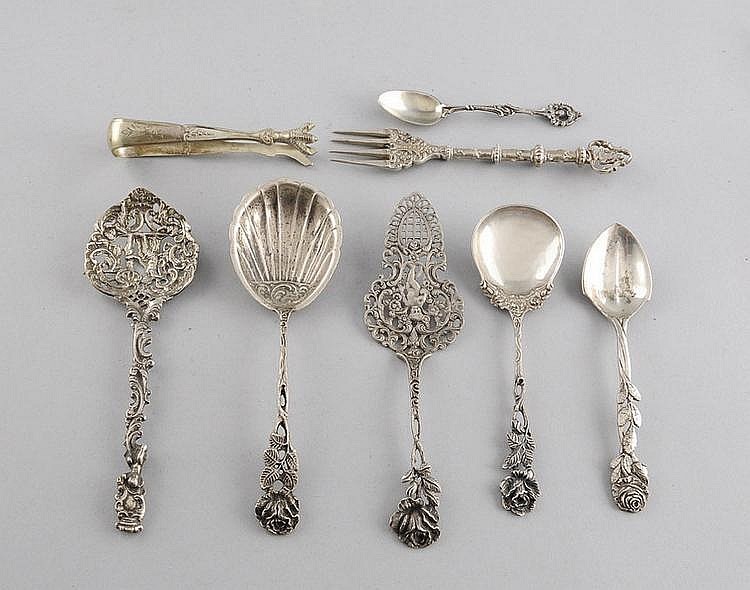 Silver
Silver
Rules for the care of cupronickel cutlery
Cupronickel alloy is considered budget, so it is used in cutlery and sideboards. But over time, this composition darkens and loses its beautiful shine. The rules for caring for this coating represent the following process:
- appliances are first immersed in a sink filled with water and detergent;
- only a soft, delicate sponge is used for cleansing;
- to achieve shine, toothpaste is used;
- after contact with water, forks and spoons must be wiped with a cotton napkin;
- products are wrapped in paper.
Causes of dark spots
The copper-nickel alloy, which forms the basis of cupronickel products, has many advantages:
- strength;
- rust resistance;
- attractive appearance;
- relatively low cost;
- long service life;
- hygiene;
- low thermal conductivity.
In addition to the advantages, products made from this material also have some disadvantages:
- rapid loss of gloss;
- the appearance of blackness;
- the need for regular care.
Cupronickel products can lose their appearance due to improper care (or lack thereof), as well as being in conditions of high humidity. The last factor is most often of paramount importance.
How to clean cupronickel spoons and products at home from blackness
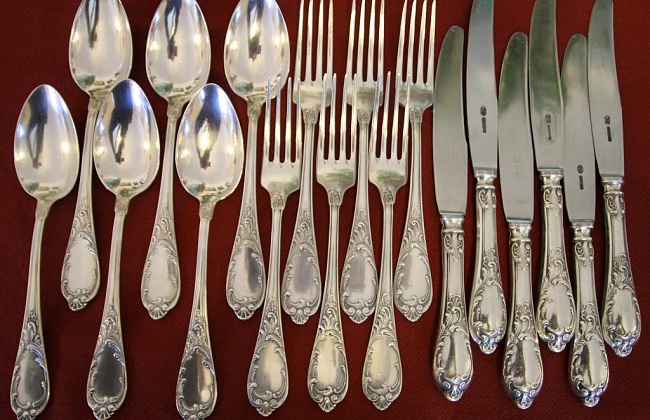
You can clean cupronickel in houses from darkening using various methods. Several basic conditions must be met:
- It is not recommended to rub copper-nickel dishes strongly, use sandpaper so as not to damage the surface layer.
- Protect your hands with rubber gloves before working with chemicals.
- Before cleaning, thoroughly rinse cupronickel with warm water and detergent to degrease the work surface.
- After cleaning by any method, thoroughly rinse the dishes and wipe dry. Sometimes it is difficult to remove all the moisture in the curves of the engraving, it is better to put the cleaned item on a towel, then wipe it dry.
- It is recommended to clean cupronickel with suede, which can not only renew the surface, but also polish it.
- Do not wash or rinse dishes with hot water.
- If cupronickel is inlaid with stones, then ammonia solution cannot be used for cleaning. It can damage the structure of the stone or remove the bonding adhesive.
10 Ways to Clean Cupronickel Cutlery
1.Use special household cleaners that are designed for silverware and cupronickel. It is better to choose liquid and gel formulations or pastes. The powder may scratch the surface of the products. Avoid products containing chlorine!
2. Dampen the sponge and add some baking soda or fine table salt. Rub your spoons, forks and knives thoroughly. After two or three minutes, you will see how cupronickel products shine. However, in this case it is difficult to clean the bends and hard-to-reach areas;
3. You can clean cupronickel cutlery with antichlor, which is sold in a pharmacy. Dissolve the drug in water and rinse the items in the composition, then rinse in clean water. This method will help to clean the material from blackness;
4. To clean cupronickel spoons, as well as knives and forks, aluminum foil for baking will help. To do this, take a wide container or pan and lay foil on the bottom. Pour one or two tablespoons of soda into the container, if desired, you can add the same amount of salt. Fold the appliances inside and pour boiling water, then put on the stove and boil. In this case, you do not even have to rub the products with a sponge or brush. At the same time, every bend and hard-to-reach place is cleaned easily and efficiently. After processing, the items will return to their original luster and appearance, they will become like new;
5.You can clean coins from cupronickel, as well as cutlery, with the help of carbonated drinks. Suitable Sprite or Coca-Cola. To do this, pour the drink into a container and put items there. Leave for a few hours and then wash with a suitable cleaning agent;
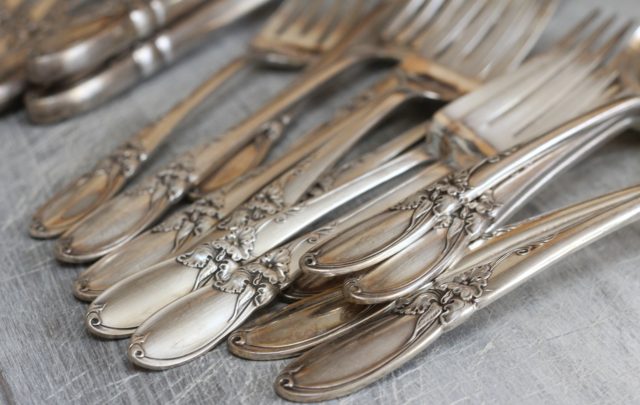
6. You can wash the plaque in water after boiling the eggs. After you have boiled the eggs, pour the liquid into an aluminum bowl. Peel the eggs, chop the shell and put in water, add a little salt. Place the products in the decoction and boil for ten minutes;
7. Instead of a decoction after eggs, you can take a decoction after potatoes.To do this, drain the liquid after boiling the potatoes into a separate container and place on the stove. Bring to a boil and turn off. Put the utensils in the decoction for twenty minutes, and then rinse in clean water. Potato broth will restore shine and eliminate pollution;
8. Onion and garlic peel is another effective folk method for cleaning cupronickel. Add the husk to the water and put on the stove. When the liquid boils, put the products inside and remove when they are completely clean;
9. Mix a tablespoon of crushed chalk with two tablespoons of ammonia. With the resulting mixture, rub the objects and polish the surface. Thus, you will return the shine and attractive appearance of the products;
10. Clean bulky cutlery with citric acid. To do this, dissolve a sachet of the product in a liter of water, put the products there and leave for two hours. The items are then washed in warm water with a suitable detergent.
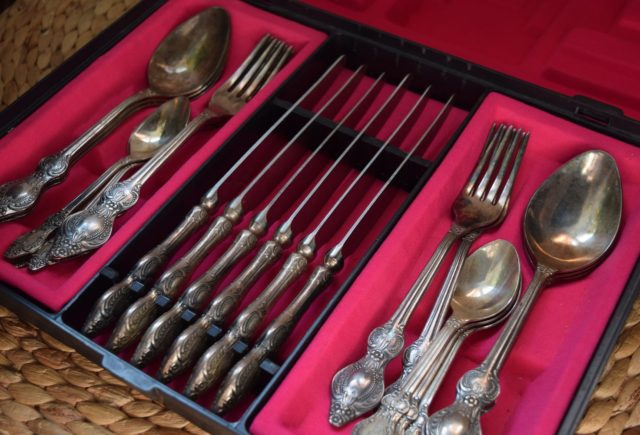
The most common ways
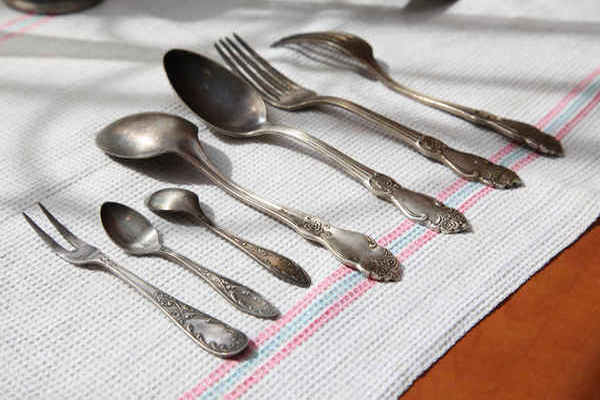 Cupronickel is a mixture of several metals, the main of which is copper. It is due to the oxidation of copper that an ugly gray-black color appears on the surface of spoons or forks.In addition to copper, cupronickel contains manganese, iron and nickel. These metals do not cause oxidation, but do not prevent it either.
Cupronickel is a mixture of several metals, the main of which is copper. It is due to the oxidation of copper that an ugly gray-black color appears on the surface of spoons or forks.In addition to copper, cupronickel contains manganese, iron and nickel. These metals do not cause oxidation, but do not prevent it either.
The smaller the area, the easier it is to remove. To remove plaque use:
- household chemicals (cleansing gels, pastes, powders and liquids);
- improvised means (soap, salt, soda);
- folk methods (consisting of mixing simple products).
Each method works effectively and does not harm the coating. You can use any method you like at will and financial possibilities.
Cleaning with household chemicals
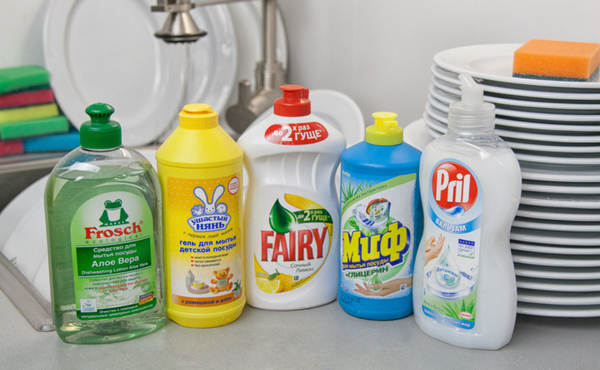
If there is a cleaning paste or gel for cleaning stoves at home, they can be used to wash cupronickel cutlery. Spoons and forks are pre-soaked in hot water with the addition of soap for 10-15 minutes. Then, a little cleaning agent is applied to a foam rubber sponge or soft cloth and wiped with objects.Leave the product on the surface for at least 10 minutes, then rinse with plenty of water.
To remove plaque, a tool designed to clean jewelry will help. It is not cheap (about 200-300 rubles), but it removes blackness well and returns the lost shine. It can be used only in accordance with the instructions indicated by the manufacturer on the back of the bottle.
When cleaning dishes with household chemicals, be sure to wear gloves and ventilate the room.
Other means
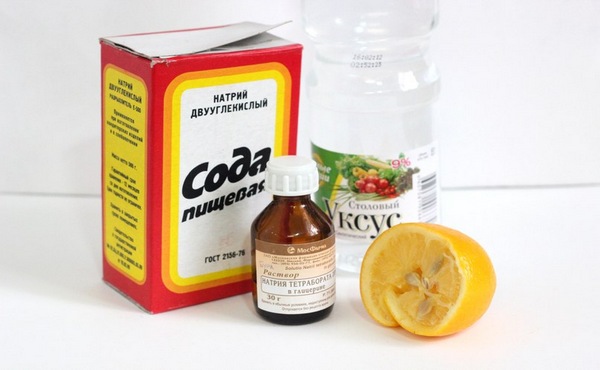
If there is ammonia at home, then you can prepare a cleaning mixture. In 3 liters of water, 3 tablespoons are diluted. ammonia and soak devices in it for 30-40 minutes. Then rub the metal with a non-rigid brush, rinse and wipe the spoons and forks dry. Ammonia is a reducing agent and will help restore products to their former beauty.
Baking soda or salt are excellent cleaning products. This method is especially effective if the oxidation has just begun and has not had time to properly penetrate the metal, then it is easy to remove it. Rub the products with any of the products for 10-15 minutes, then rinse. Citric acid has a similar effect, it gently acts on plaque and removes it from the surface.
A soap solution will help to cope with light dirt and dried grease, but soap is practically useless against oxide (only small spots). In 3 liters of water dissolve 2-3 tbsp. liquid soap and soak spoons with forks for a few minutes. First, the appliances are washed with foam, and then with clean water.
A weak solution of vinegar can restore the sparkle of the surface. Prepare a solution: take 2 tbsp per liter of water. 9% vinegar. Wet a swab in the mixture and spend it several times over the product. There is dirt on the swab. When the entire swab turns black, take a fresh one and repeat the manipulation until the devices sparkle like new.
Folk ways
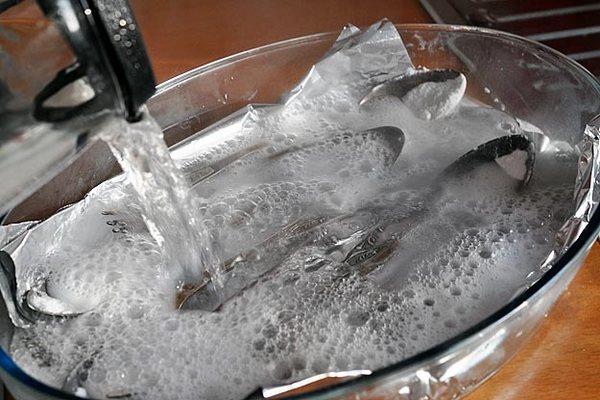
One unusual cleaning method is known among the people, for which foil is needed.It is placed on the bottom of the pan, 2-3 tablespoons are poured on top. baking soda (salt is also suitable) and pour water almost to the top of the pan. Immerse cupronickel cutlery in water and heat the pan until it boils. Boiling should continue for at least 10 minutes. At the same time, oxides remain in the water, and the metal has noticeably become cleaner.
If there is no foil at home, it's okay. Hard-boiled eggs are boiled, but the water is not poured out from under them. The shells from boiled eggs are placed in it, and then the appliances are lowered. Let the pot heat up for 10 minutes. For best results, you can add 1 tbsp.salt.
A mixture prepared from chalk and ammonia has a wonderful effect. Take:
- 2 tbsp ammonia;
- ½ cup of water;
- 1 tbsp crumbled chalk.
With the resulting solution, wipe the devices with a napkin, lightly rubbing into the metal. The gray coating will leave immediately, even from hard-to-reach places, and the blackness will become less noticeable, but after 3-4 cleanings it will completely disappear.
Sodium thiosulfate solution will help get rid of black spots on cutlery. It is sold in pharmacies, is safe to use and does not require dilution.
Some housewives advise using a decoction of garlic peel. Husks from 3-4 garlic are added to the water, the contents are poured into a saucepan and the tableware is immersed. Boil for 10-15 minutes, then wash with water and dry.
Ordinary soda is also used for cleansing. Pour the spoons and forks with soda and leave for half an hour. Then rinse and polish the products with a microfiber cloth.
How to care for cupronickel so that it does not darken
It is not enough to figure out how to quickly clean cupronickel. It is also necessary to make sure that products from it do not darken for as long as possible. To do this, it is worth observing the following rules for handling such metal:
- Store it only in places where chlorine-based products cannot reach.
- Wash products made of this metal only in non-hot water.
- Always wipe cupronickel spoons, forks, knives dry. Never store them if they are still slightly damp.
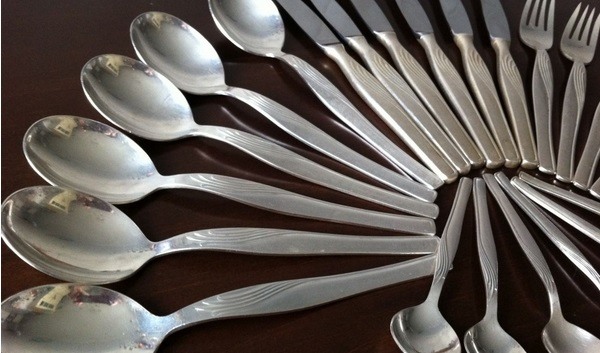 If you follow these recommendations, you will rarely have to clean your cupronickel products. You can completely forget about the use of special tools for this.
If you follow these recommendations, you will rarely have to clean your cupronickel products. You can completely forget about the use of special tools for this.
Video: sparkling spoons in minutes:
Care Tips
Items made of cupronickel attract with a dazzling brilliance, and in order to keep them in an elegant form, you need to take care of the products in a timely manner.
The devices are thoroughly wiped and stored in a dry place. If you want to protect items from excessive moisture, then each of them is recommended to be wrapped in foil.
Experts assure that cupronickel dishes do not tolerate chlorine. Therefore, in order to avoid darkening of the alloy, it is recommended to keep items away from any products containing such a component.
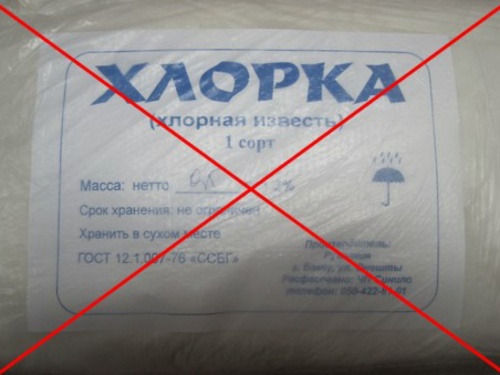
Cupronickel cutlery should be polished frequently and placed in a separate drawer, away from other items. The polishing process should be carried out once every 2 weeks. The tool can be bought at a household store or prepared at home. You just need to mix 150 ml of water, 90 ml of ammonia, 45 g of chalk until a homogeneous consistency, then process the items, rinse them and wipe them with a kitchen towel.
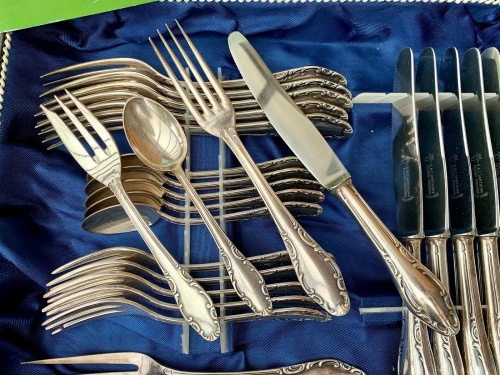
If cupronickel products are in open space, then dark spots will appear on the surface. Therefore, items must be stored in a special closed case.
You can wash cupronickel from blackness very quickly and effectively if you know homemade recipes and apply recommendations for the proper care of this alloy.
Professional chemicals
Cupronickel appliances can be cleaned using household chemicals. Products are presented in the form of liquids, creams, pastes, special impregnated wipes.
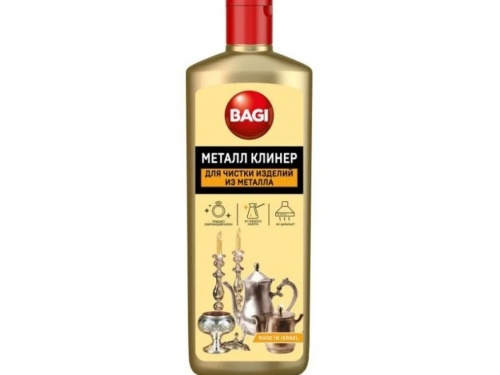
According to customer reviews, the following are the best:
- Metal Cleaner perfectly eliminates darkening and various impurities from brass, cupronickel, stainless steel, bronze.The agent is applied to the products, then the objects are rinsed and wiped.Metal Cleaner returns the original shine to the material, polishes and leaves no defects. In the store, a bottle costs about 550 rubles.
- Cinderella. Manufacturers produce the component in the form of a concentrate that has a thick consistency. Universal cleaner cleans cupronickel, copper, chrome, stainless steel. Thanks to the minerals that make up the preparation, scratches and stains do not remain on the surface of the devices. The cream is applied either to the product or to a soft cloth, which is then used to wipe the items. The product is sold in various volumes and costs from 100 rubles.
- Unicum removes blackness and plaque well without leaving scratches on the surface. The product is suitable for cleaning cupronickel, brass, silver, gold, copper, bronze. If cupronickel products are covered with Teflon or there is a painting on the surface, then it is better not to use this tool. The product can be purchased for 180 rubles.
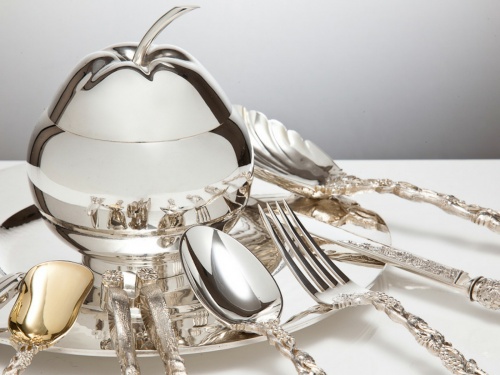
When using household chemicals or solutions made from natural ingredients, wear rubber gloves.
How to save the result
In order to prolong the life of cutlery, adhere to the following rules:
- Keep cupronickel spoons and forks in places with low humidity.
- Do not use Whiteness and similar chlorine-containing products to wash them.
- Not mine in the dishwasher.
- Store cupronickel products tightly wrapped in cling film or foil, this will protect them from the aggressive effects of oxygen, and grandmother's favorite cupronickel spoons will retain their original shine for longer.
What to do so that black plaque does not appear on cupronickel cutlery
How to care for cupronickel to ensure the products look great:
- We wipe knives, forks and spoons from cupronickel always only dry;
- Products are stored in zip bags with a convenient lock that will perfectly protect the contents from moisture and dust;
- Cutlery should be regularly wiped with a flannel soft cloth, coarse wool, or use a special napkin for cleaning silver;
- A wooden box that closes tightly is also well suited for storing appliances. Inside it, you need to put a piece of chalk, which will protect the products from oxidation.
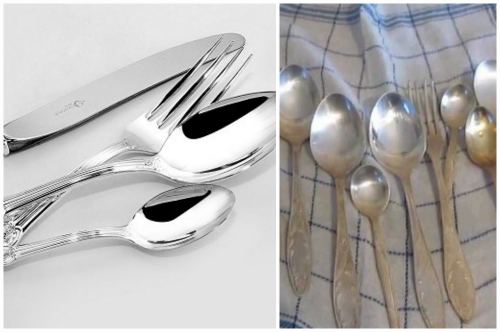
These methods are highly efficient and not labor intensive.
6 Rules for Preserving Color
In order for things made of cupronickel to retain their appearance longer, it is necessary to adhere to the following rules:
- Store products in a place with low humidity.
- Do not use products containing chlorine for cleaning.
- Cupronickel cannot be washed in a dishwasher.
- For long-term storage, it is recommended to wrap products in foil or film to limit oxygen access and reduce the likelihood of oxidative processes. You can also keep products in tightly closed wooden boxes by adding a piece of chalk. An alternative is ziplock bags.
- After washing cupronickel dishes should be wiped dry.
- Nickel silver jewelry is undesirable to wet. Before contact with water (washing hands, taking a shower, etc.), they should be removed.
